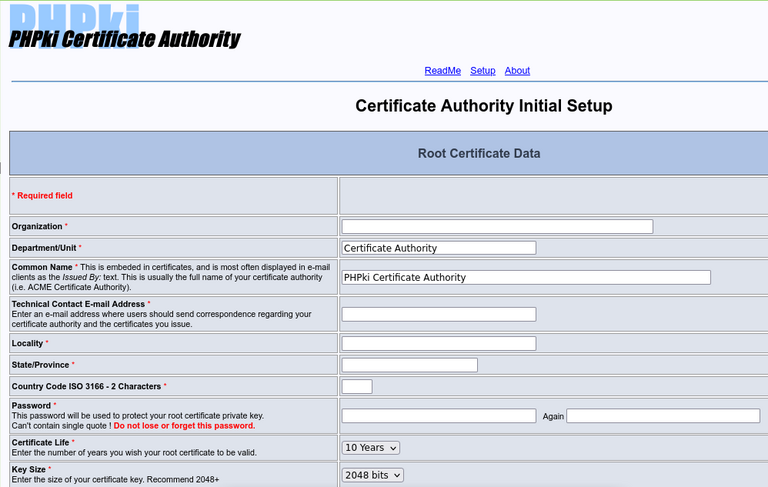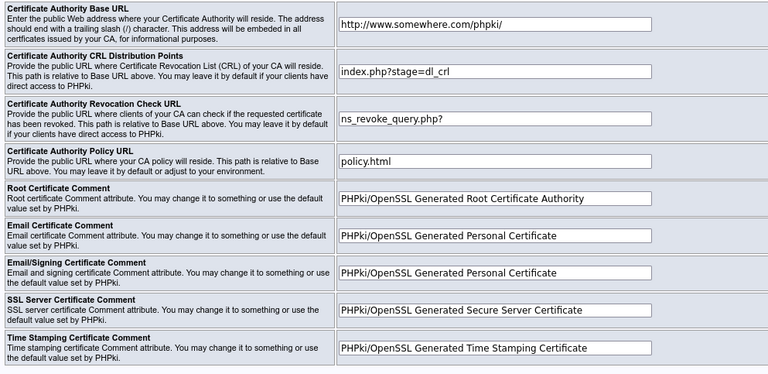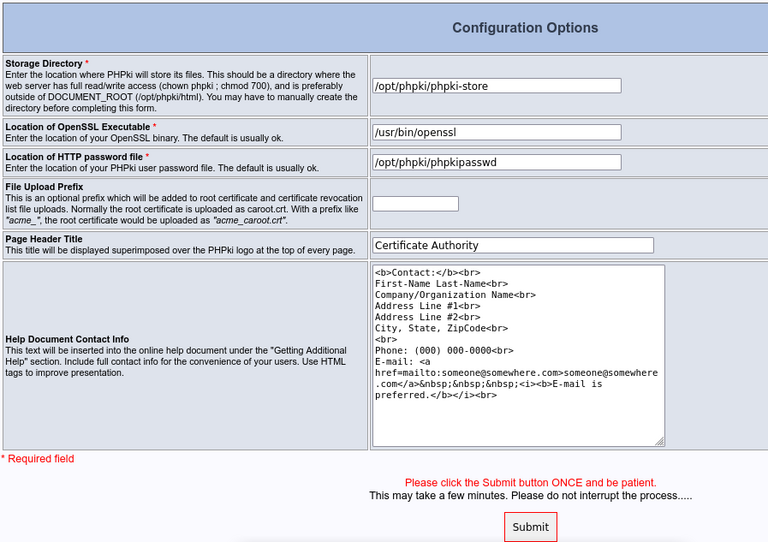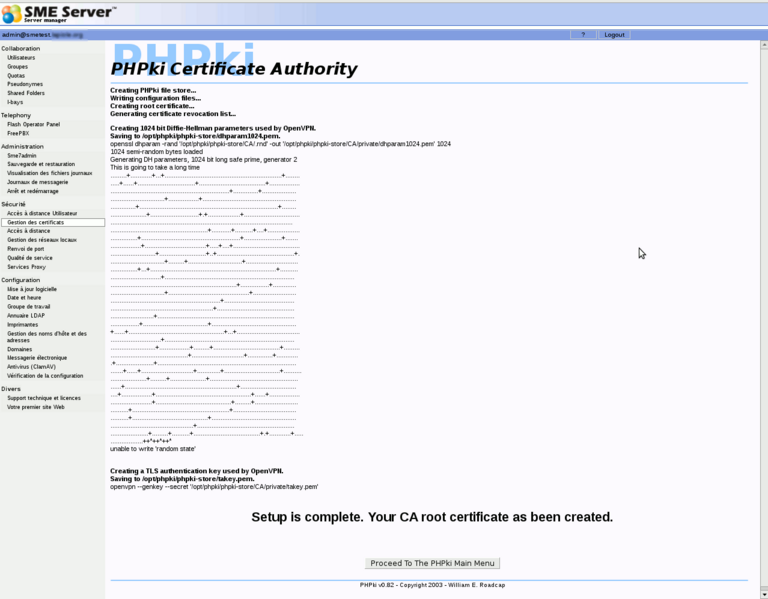PHPki
Maintainer
Previous: [1]Daniel B. from Firewall Services
Now maintained by Koozali SME
Version
Old version prior SME10:smeserver-phpki and phpki
New Version:
Please follow the installation instructions below. The installation instructions will satisfy all dependencies and the latest versions of the above 2 RPMs will be installed automatically.
Description
PHPki is an Open Source Web application for managing a multi-agency PKI for HIPAA compliance. With it, you may create and centrally manage X.509 certificates for use with S/MIME enabled e-mail clients, SSL servers, and VPN applications. PHPki is now used to manage certificates with the latest release of the SME Server OpenVPN Bridge contrib.
You can see a demo installation here
Requirements
- SME Server 7.X
Verified on: SME Server 7.4 - RequestedDeletion
Installation
- install the rpms
yum --enablerepo=smecontribs install smeserver-phpki-ng
go to the server-manager to the manage certificate menu and start creating your CA certificate
Warning click only once and wait for the page to update it can be very long to create the 4096 certificate...
you have to enable the epel repository
- install the rpms
yum --enablerepo=smecontribs,epel install smeserver-phpki
- and start/restart needed services:
expand-template /etc/httpd/conf/httpd.conf expand-template /etc/httpd/pki-conf/httpd.conf sv t /service/httpd-e-smith sv u /service/httpd-pki
- alternatively issue the following :
signal-event post-upgrade; signal-event reboot
on update you can issue
expand-template /etc/httpd/conf/httpd.conf expand-template /etc/httpd/pki-conf/httpd.conf sv t /service/httpd-e-smith sv t /service/httpd-pki
For sme8
- install the rpms
yum --enablerepo=smecontribs install smeserver-phpki
- and start/restart needed services:
expand-template /etc/httpd/conf/httpd.conf expand-template /etc/httpd/pki-conf/httpd.conf sv t /service/httpd-e-smith sv u /service/httpd-pki
- alternatively issue the following :
signal-event post-upgrade; signal-event reboot
Configure your new PKI
Go in the server-manager, you'll find a new "Manage Certificates" menu (or you can use the URL https://server.domain.tld/phpki/ca) Here you have to enter the following informations:
- Organisation
- Department
- Common Name of the Master CA
- E-mail (technical contact)
- City
- State
- Country Code
- Password (to protect the private key of the Master CA)
- Validity of the CA
- Keys size
- URL of your PKI (https://my.domain.tld/phpki)
These two screenshots illustrate the first (and the most important) part of this configuration page:
The second part is like this:
The default settings should be OK for most installations. You may just want to change the "Help Document Contact Info" part.
Once you have submitted this form (which can take several minutes, be patient, as generating dh parameters can take a long time), you should have something like this:
Now you'll be able to start using PHPki. It's quite easy to use.
The administrative interface is available on the server-manager or directly https://my.domain.tld/phpki/ca
There's also a public interface, available only from the local networks, but without password at https://my.domain.tld/phpki. Here, users can download the Master CA certificate, the CRL, or search for certificates of other users (public part only of course).
Migrate Certificates from previous OpenVPN-Bridge contrib installations
If you are installing this phpki contrib because you have used OpenVPN_Bridge before and have already certificates, follow the instructions below. If you have a fresh and new install of OpenVPN_Bridge, skip the below instructions for you do not have 'old' certificates!
PHPki is now the certificate manager recommended to manage OpenVPN_Bridge certificates. This part will explain how-to import your certificates created with openvpn-bridge into PHPki
- First, you need to install the contribs as it's explain on this page (you can enter anything for the configuration of the CA, all your old parameters will be restored)
- Second, you need to copy this script on your server (for example as /root/migrate.sh) and execute it as root.
#!/bin/bash
# Read Openvpn-Bridge DB
ORGNAME=$(/sbin/e-smith/db openvpn-bridge getprop default_config organizationName)
COUNTRY=$(/sbin/e-smith/db openvpn-bridge getprop default_config countryCode)
STATE=$(/sbin/e-smith/db openvpn-bridge getprop default_config countryName)
LOC=$(/sbin/e-smith/db openvpn-bridge getprop default_config localityName)
DEP=$(/sbin/e-smith/db openvpn-bridge getprop default_config sectionName)
KEYSIZE=$(/sbin/e-smith/db openvpn-bridge getprop default_config keySize)
EMAIL=$(/sbin/e-smith/db openvpn-bridge getprop default_config mailAddress)
OPENSSL=/usr/bin/openssl
OLDDIR=/etc/openvpn/easy-rsa/keys/bridge/
NEWDIR=/opt/phpki/phpki-store/CA/
# Store the actual time in $TIME
TIME=$(date +%d%m%Y%H%M%S)
# Create needed directories
prepare_dir(){
mkdir -p $NEWDIR/{certs,newcerts,requests,pfx,private}
}
# Migrate the certificates to phpki store
migrate_certs(){
cd $OLDDIR
# Copy the old index.txt and serial
cat $OLDDIR/index.txt > $NEWDIR/index.txt
cat serial > $NEWDIR/serial
# Copy the cacert related files
cat ca.crt > $NEWDIR/certs/cacert.pem
cat ca.key > $NEWDIR/private/cakey.pem
# Now, for each file ending with .crt
for CERT in $(ls ./*.crt); do
CERT=$(basename $CERT .crt)
ISININDEX=$(grep -c "/CN=$CERT/" $NEWDIR/index.txt)
# If the current cert isn't referenced in the index,
# or the corresponding key or csr file dosn't exists, then skip it
# This can happen in some situation where the serial has been corrupted
if [ $ISININDEX -gt 0 ]&&[ -s $CERT.key ]&&[ -s $CERT.csr ]; then
# Retrieve the serial number as reported by openssl
SERIAL=$(openssl x509 -noout -serial -in $CERT.crt | cut -d"=" -f 2)
# Create the pem only cert in the new dir
$OPENSSL x509 -in $CERT.crt -inform PEM -outform PEM -out $NEWDIR/newcerts/$SERIAL.pem
# Create the der formated cert
$OPENSSL x509 -in $CERT.crt -inform PEM -outform DER -out $NEWDIR/certs/$SERIAL.der
# And the pkcs12 bundle (cert+key+ca)
$OPENSSL pkcs12 -export -in $CERT.crt -inkey $CERT.key -certfile ca.crt -caname $ORGNAME -passout pass: -out $NEWDIR/pfx/$SERIAL.pfx
# Copy the private key
cat $CERT.key > $NEWDIR/private/$SERIAL-key.pem
# And the cert request
cat $CERT.csr > $NEWDIR/requests/$SERIAL-req.pem
fi
done
}
perms(){
# Restrict access
chown -R phpki:phpki $NEWDIR
chmod -R o-rwx $NEWDIR
}
phpki_conf(){
# Retrieve the common name of our CA with openssl command
CACN=$($OPENSSL x509 -subject -noout -in $OLDDIR/ca.crt | cut -d'=' -f 8 | cut -d'/' -f 1)
if [ -e /opt/phpki/phpki-store/config/config.php ]; then
# Move the actual phpki configuration file
mv /opt/phpki/phpki-store/config/config.php /opt/phpki/phpki-store/config/config.php.$TIME
# And use sed to configure it properly
sed -e "s/config\['organization'\].*/config\['organization'\] = '$ORGNAME';/" \
-e "s/config\['unit'\].*/config\['unit'\] = '$DEP';/" \
-e "s/config\['contact'\].*/config\['contact'\] = '$EMAIL';/" \
-e "s/config\['locality'\].*/config\['locality'\] = '$LOC';/" \
-e "s/config\['province'\].*/config\['province'\] = '$STATE';/" \
-e "s/config\['country'\].*/config\['country'\] = '$COUNTRY';/" \
-e "s/config\['common_name'\].*/config\['common_name'\] = '$CACN';/" \
-e "s/config\['ca_pwd'\].*/config\['ca_pwd'\] = '';/" \
-e "s/config\['keysize'\].*/config\['keysize'\] = '$KEYSIZE';/" \
/opt/phpki/phpki-store/config/config.php.$TIME \
> /opt/phpki/phpki-store/config/config.php
fi
}
migrate_var(){
# Here, we just migrate dhparam and ta to phpki store
if [ -e $OLDDIR/dh.pem ]; then
cat $OLDDIR/dh.pem > $NEWDIR/private/dhparam1024.pem
fi
if [ -e $OLDDIR/ta.key ]; then
cat $OLDDIR/ta.key > $NEWDIR/private/takey.pem
fi
}
prepare_dir
migrate_certs
phpki_conf
migrate_var
perms
Now, go in the server-manager, in "Manage Certificates" and check your old certificates are here.
Uninstall
To uninstall the contrib from your server, just run the following commands:
yum remove smeserver-phpki-ng phpki-ng expand-template /etc/httpd/conf/httpd.conf sv t /service/httpd-e-smith
Certificates and PKI configuration are stored in /opt/phpki/phpki-store, php files are in /opt/phpki/html
Re-install
If you have removed the contrib, and want to re-install it, you'll need to follow these steps after you have installed the rpms:
cd /opt/phpki/html/ rm -f index.php rm -f setup.php ln -s main.php index.php cat config.php.rpmsave > config.php cd ca rm -f index.php ln -s main.php index.php cd /opt/phpki/ chown phpki:phpki -R phpki-store chown root:phpki -R html/config.php
Bugs
Please raise bugs under the SME-Contribs section in bugzilla
For the old smeserver-phpki select the smeserver-phpki component or use this link
| ID | Product | Version | Status | Summary |
|---|---|---|---|---|
| 12297 | SME Contribs | 10.0 | CONFIRMED | ldap entries need to be sanitize. |
For the new smeserver-phpki-ng select the smeserver-phpki-ng component or use
this link
| ID | Product | Version | Status | Summary (4 tasks) ⇒ |
|---|---|---|---|---|
| 12436 | SME Contribs | 10.0 | CONFIRMED | failure to download crl |
| 12426 | SME Contribs | 10.0 | CONFIRMED | smeserver-phpki-ng Setting httpd-pki PHPVersion does not alter template |
| 12228 | SME Contribs | 10.0 | RESOLVED | wrong uid and gid |
| 10903 | SME Contribs | Futur | CONFIRMED | NFR: Save certificate bundle for ovpn configs |
Use this for bugs phpki-ng itself this link
| ID | Product | Version | Status | Summary (2 tasks) ⇒ |
|---|---|---|---|---|
| 12420 | SME Contribs | 10.0 | CONFIRMED | phpki-ng Create and download file has no name |
| 12275 | SME Contribs | 10.0 | CONFIRMED | PHP Warning: Use of undefined constant |



